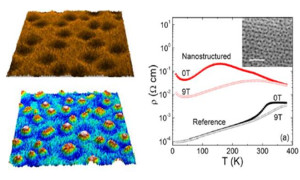Self-assembled materials
Self-assembled materials
Spontaneous self-organized antidots
[slideshow_deploy id=’573′]
Bottom-up approaches to nanostructure functional materials are of crucial interest to develop inexpensive and efficient devices for nanotechnology applications. In the case of oxide thin films, the simultaneous occurrence of various degrees of freedom in the relaxation of misfit strain with the substrate offers a way to exploit spontaneous self-organization processes. We are interested in obtaining nanostructured surfaces in different functional oxides. For this it is necessary a profound understanding of the elastic interaction between film and terraced substrate and the competition between kinetic and thermodynamic processes during thin film growth. Advanced structural and morphological characterizations are performed in oxide thin films to gain a deeper insight into nanostructuration mechanisms.
Functional properties
[slideshow_deploy id=’584′]
The strong coupling between lattice, charge, orbit and spin degrees of freedom in manganite thin films opens the possibility to engineer their functional properties through a fine tuning of the growth kinetics. In particular, strained states that are not accessible in bulk form may be attained by controlling growth parameters. We are interested in the influence of kinetically driven surface instabilities leading to nanostructured oxide materials on the functional properties as, for example, magnetic anisotropy or magnetoresistance.
Guided self-assembly of Nanoobjects
[slideshow_deploy id=’589′]
Positioning nanoobjects in regular patterns is one of the major goals in nanotechnology. A promising and inexpensive approach is to use spontaneously formed nanostructures as templates for the guided self-assembly of nanoparticles. In this way, obtaining ordered arrays of nanoelements not only may help to overcome the fundamental limits of nanofabrication technologies but also it could stabilize crystal phases and structures not achieved otherwise. The assembly of magnetic atoms also opens the possibility to study spin-dependent transport at reduced dimensions, of technological interest in spintronics. We are concentrated on the direct assembly of different metal (Au, Ag, Pt, …) and oxide (FeOx, …) nanoparticles on top of self-organized manganite templates.
